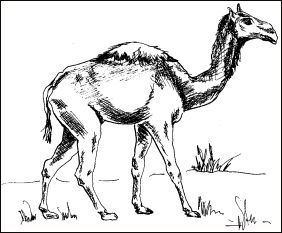

Camels, like horses, had most of their evolutionary history in North America, with early forms appearing in the Late Eocene Epoch, over 35 million years ago. During the Pliocene, before the onset of the Pleistocene ice ages, emigrant camels to the Old World left, to eventually evolve into the Asiatic Bactrian and the African Dromedary camels; other emigrants entered South America to give rise to today's llamas, alpacas, and vicuñas.
What is now the northern Chihuahuan Desert supported several kinds, some truly gigantic. Two survived locally until the great die-off at the end of the ice ages, some 11,000 years ago. One apparently looked much like an over-sized dromedary. The other, equally tall, was built like modern llamas—long-legged, slender creatures.
Loss of horses and camels from the North American scene left us all the
poorer, and the causes are hotly argued. Modern conditions are suitable for horses, as
shown by today's feral herds, but camels turned loose in the Southwest during in
the Civil War era eventually disappeared, leaving the continent once more without these
magnificent animals.

Listen to the Audio (mp3 format) as recorded by KTEP, Public Radio for the Southwest.
Contributor: Arthur H. Harris, Laboratory for Environmental Biology, Centennial Museum, University of Texas at El Paso.
Desert Diary is a joint production of the Centennial Museum and KTEP National Public Radio, University of Texas at El Paso.

Drawing of an extinct camel (Camelops hesternus, which survived in the El Paso region until about 11,000 years ago.
Hall of Florida Fossils. Good overall treatment.